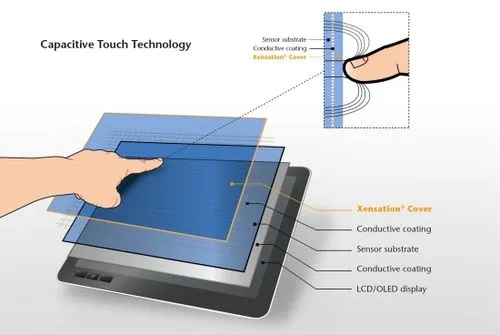Introduction: The Touchscreen Revolution
Touchscreen technology has fundamentally changed how we interact with our devices, making them more intuitive, user-friendly, and integral to our daily lives. This article delves into the history and evolution of touchscreen, tracing its journey from early experimentation to the sophisticated systems we rely on today.

The Origins of Touchscreen Technology
The 1960s: Pioneering Experiments in User Interaction
The origins of touchscreen-technology date back to the 1960s when engineers began exploring innovative ways to enable direct user interaction with screens. In 1965, American scientist Dr. Thomas Swan made a significant contribution by filing a patent for an “electric sensor device” that utilized capacitive technology to detect human touch. Despite this early breakthrough, touchscreen technology did not gain widespread recognition until much later in the 20th century.
Initial Commercial Applications
1980s: The First Commercial Touchscreen Devices
The first commercial applications of touchscreen technology emerged in the early 1980s. IBM played a pioneering role with the release of the 5820 Personal System/2 in 1982, which featured a stylus-based touchscreen. Around the same time, GRiD Systems Corporation, a San Francisco-based computer manufacturer, introduced the GRiD Compass, a portable computer with a stylus-based touchscreen display. These devices marked the beginning of touchscreen technology’s journey into the consumer market.
The Rise of Smartphones
Early 2000s: The Smartphone Revolution
Touchscreen technology saw significant advancements in the early 2000s with the advent of smartphones. In 2001, Pioneer Corporation launched the Pioneer P-1, a smartphone equipped with a stylus-based touchscreen. Following this, IBM introduced the ThinkPad 2005, which featured a resistive touchscreen operable with either a stylus or a finger. These early smartphones set the stage for what was to come, but it was Apple Inc. that truly revolutionized the industry.
The Apple Breakthrough
2007: The iPhone and the Multi-Touch Revolution
The turning point for touchscreen technology came in 2007 when Apple Inc. unveiled the iPhone. The iPhone’s multi-touch display, which allowed users to interact with the screen using multiple fingers, revolutionized mobile devices. This innovation not only popularized touchscreen technology but also set new standards for the design and functionality of smartphones, leading to a new era of mobile interaction.
Modern Advancements: The Continuous Evolution of Touchscreens
Today’s Touchscreens: More Responsive and Intuitive Than Ever
Since the introduction of the iPhone, touchscreen technology has continued to evolve rapidly. Modern smartphones and tablets now feature high-resolution displays with advanced capabilities such as 3D touch, haptic feedback, and gesture recognition. These advancements have made touchscreen devices more responsive, intuitive, and integrated into our daily lives than ever before.
Conclusion
Touchscreen technology has come a long way since its inception in the 1960s, evolving from rudimentary sensors to the sophisticated systems that define our mobile devices today. As technology continues to advance, the future of touchscreen devices looks promising, ensuring that these intuitive interfaces will remain central to our digital experiences for years to come.
Summary FAQ: Understanding the Evolution
Q: When did touchscreen technology first emerge?
A: Touchscreen technology originated in the 1960s, with Dr. Thomas Swan’s 1965 patent for a capacitive touch sensor device being one of the earliest developments.
Q: What were some of the first commercial touchscreen devices?
A: The first commercial touchscreen devices included IBM’s 5820 Personal System/2 (1982) and GRiD Systems Corporation’s GRiD Compass, both featuring stylus-based touchscreens.
Q: How did the iPhone revolutionize touchscreen technology?
A: In 2007, Apple’s iPhone introduced a multi-touch display that allowed users to interact with the screen using multiple fingers, revolutionizing mobile device interaction and setting new industry standards.
Q: What are some modern advancements in touchscreen technology?
A: Modern touchscreen technology includes features like 3D touch, haptic feedback, and gesture recognition, which enhance the responsiveness and intuitiveness of today’s smartphones and tablets.
